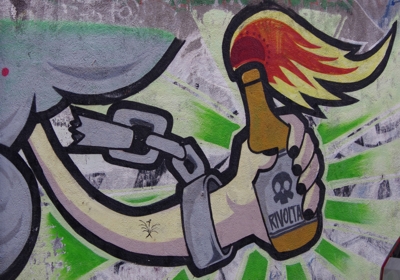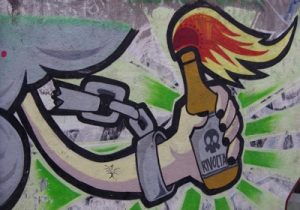
New article on Prefigurative Politics in Social Movement Studies

anarchist graffiti by SNappa2006
Power relations within social movements are an enormous source of dispute and argument in contemporary activism, and so are questions about the strategic significance of alternative practical projects such as occupations, alternative media, communes, ‘zines, radical bookshops, social centres, and other resources. Both areas also attract academic attention in answering questions about understanding how participants build collective identity, how movements sustain themselves in periods of low mobilisation, and how different types of resources shape movement practices.
In some of these discussions, the concept of prefiguration has been used to help understand the importance of practical projects or ‘alternatives’, and of the politics underpinning social movement organising itself. This is the subject of a paper I have recently written for the journal Social Movement Studies – you can get the full text here currently for free, or an earlier version on academia.edu here (get in touch if you have any problems).
The article uses the example of social centres – self-managed cultural and political spaces based in Barcelona, Spain – to think through the concept of prefiguration, which refers to forms of non-adversarial political action which ‘prefigure’ alternative futures, and forms of action where the politics of protest itself are considered important, a kind of meta-politics often associated with identity- and ‘new social movements’. This discussion comes out of a wider project about the relationship of daily life with political protest begun in my PhD: intersections between cultural groupings and political movements, ‘everyday’ forms of politics, and the social context and daily life in which activism takes place.
The idea of prefiguration or prefigurative politics has been used as a kind of qualifier for distinguishing anarchism from other forms of socialism, for defining direct action and is often contrasted with ‘old left’ models of organisation (Breines 1989, Graeber 2002, Franks 2003, Maeckelbergh 2009). The term and its key ideas have been increasingly deployed for making sense of a variety of protest activities, and for an array of political movements including environmental direct action (Szerszynski 1999), the alter-globalisation movement (Maeckelbergh 2011) and recent occupations of public space such as the Spanish Indignados and Occupy (Juris 2012, Rasza and Kurnick 2012).
The article argues that the use of the concept of prefiguration in making distinctions among movements or tactics has tended to caricature rather than illuminate differences. Part of the problem is a bifurcation in how it is used. I review and organise the literature on prefiguration into two camps: roughly those which refer to scenarios where protesters express the political ‘ends’ of their actions through their ‘means’, or where they create experimental or ‘alternative’ social arrangements or institutions. Both meanings share the idea that prefiguration anticipates or partially actualises goals sought by movements. It isn’t usually clear in cases where authors claim that ‘means’ are ‘ends’ what the full variety of processes or goals are for these groups, and which of the ‘means’ reflect which ‘ends’. In cases where prefiguration refers to experiments and ‘alternatives’, meanwhile, it is usually unclear where commentators, or social movement participants, think politics and political action start and finish. This latter point also makes the question of how or on what terms prefiguration is ‘political’ – or in what sense it contributes to social movement goals – of importance to movement strategy and knowledge.
The article draws on interviews with people involved in feminism and queer politics, anti-racism, anarchism and environmentalist movements in Barcelona’s autonomous social centres. These spaces are used by a mixture of people: movement organisations, youth cultural groupings and people who want to experiment with daily life such as communal, or environmentally low-impact, living. Political action is understood and defined in a variety of senses, and the resulting tensions suggest that questions around effectiveness, strategy and micropolitics are rarely resolved even in small groups and networks. Political action, and particularly those aspects which do not have a direct impact, is always a temporary outcome in which multiple goals, and multiple means, are negotiated and differently prioritised. This leads to an alternative formulation of how prefiguration can be understood and used analytically to think about movement practice.
Prefigurative forms of political action, it is argued, combine five processes: collective experimentation; the imagining, production and circulation of political meanings or frames; the creating of new and future-oriented social norms or ‘conduct’; their consolidation in movement infrastructure; and the diffusion and contamination of ideas, messages and goals to wider networks and constituencies. In groupings where politics is prefigurative many of the strategic tensions operate through differences of opinion about how much each of these processes should be prioritised, as well as their content. Experimentation and the production of political meanings might take priority for some movement networks or individuals within them; the question of what is experimented with and what political meanings are produced produces another set of potential cleavages.
This approach therefore tries to clarify along what lines prefigurative groups can be differentiated from subcultural or counter-cultural groups, who normally do not try to consolidate, proliferate and diffuse their perspectives and collective conducts. It also differentiates prefigurative groups from political groups, often more formal organisations – where experimentation, knowledge production and ‘new conduct’ are less important. It also challenges the idea that some homology between ‘means’ and ‘ends’ is a useful way of defining apart some political actions or groups from others.
The piece argues, therefore, that prefiguration involves combining the imaginative construction of ‘alternatives’, within either mobilisation-related or everyday activities, with some strategic attempt to ensure their future political relevance. The way in which these priorities are navigated can sensitise analysis to differences between prefigurative groupings, schisms within them, and ideological barriers between prefigurative groups and other movements or groupings. It is now rather well documented that many movements and social groupings are preoccupied with the politics of their practices in some respects, and clear that most engage in a whole range of practices which do not relate immediately to movement goals. Recent mobilisations which demonstrate the political importance of organisational forms and public space such as Occupy and 15-M, and the difficulty in expressing demands where a wide variety of political goals are sought, would suggest that more thinking is needed to understand how such practices configure social movement emergence, change, and success.
Luke Yates
Department of Sociology/Sustainable Consumption Institute
University of Manchester
Image from SNappa2006 on Flickr (Creative Commons license)
References
Boggs, C. (1977). Marxism, prefigurative communism and the problem of workers’ control. Radical America, 6 (Winter), pp.99–122.
Breines, W. (1989). Community and Organization in the New Left 1962-68: The Great Refusal, New Brunswick, NJ: Rutgers Univ. Press.
Franks, B. (2003). The direct action ethic: From 59 upwards. Anarchist Studies, 11(1), pp.13–41.
Graeber, D., 2002. A Movement of Movements: The New Anarchists. New Left Review, 13, pp.61–73.
Juris, J.S. (2012). Reflections on #Occupy Everywhere: Social media, public space, and emerging logics of aggregation. American Ethnologist, 39(2), 259-279.
Maeckelbergh, M. (2009). The will of the many: how the alterglobalisation movement is changing the face of democracy, London: Pluto Press.
Razsa, M. & Kurnik, A. (2012). The Occupy Movement in Žižek’s hometown: Direct democracy and a politics of becoming. American Ethnologist, 39(2), pp.238–258.
Yates, L. (2014). Rethinking Prefiguration: Alternatives, Micropolitics and Goals in Social Movements. Social Movement Studies at http://www.tandfonline.com/doi/pdf/10.1080/14742837.2013.870883
 Luke Yates
Luke Yates
I currently work as a Hallsworth Research Fellow in the Department of Sociology. My research is about the sociology and politics of consumption and eating, daily practices, household living arrangements, and social movements. I have been a member of movements@manchester since its inception and co-organised its second one-day workshop ‘Movements and Change’ in January 2012.





0 Comments